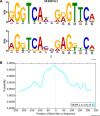The MEME Suite
- PMID: 25953851
- PMCID: PMC4489269
- DOI: 10.1093/nar/gkv416
The MEME Suite
Abstract
The MEME Suite is a powerful, integrated set of web-based tools for studying sequence motifs in proteins, DNA and RNA. Such motifs encode many biological functions, and their detection and characterization is important in the study of molecular interactions in the cell, including the regulation of gene expression. Since the previous description of the MEME Suite in the 2009 Nucleic Acids Research Web Server Issue, we have added six new tools. Here we describe the capabilities of all the tools within the suite, give advice on their best use and provide several case studies to illustrate how to combine the results of various MEME Suite tools for successful motif-based analyses. The MEME Suite is freely available for academic use at http://meme-suite.org, and source code is also available for download and local installation.
© The Author(s) 2015. Published by Oxford University Press on behalf of Nucleic Acids Research.
Figures








References
-
- Bailey T.L., Elkan C.P. Fitting a mixture model by expectation-maximization to discover motifs in biopolymers. In: Altman R, Brutlag D, Karp P, Lathrop R, Searls D, editors. Proceedings of the Second International Conference on Intelligent Systems for Molecular Biology. Menlo Park, CA: AAAI Press; 1994. pp. 28–36. - PubMed
-
- Bailey T.L., Elkan C. Fitting a mixture model by expectation maximization to discover motifs in biopolymers. Proc. Int. Conf. Intell. Syst. Mol. Biol. 1994;2:28–36. - PubMed
Publication types
MeSH terms
Substances
Grants and funding
LinkOut - more resources
Full Text Sources
Other Literature Sources

